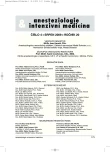The utilization of fiberoptic bronchoscopy in intensive care
Authors:
Bartáková Hana 1; Otáhal Michal 1; Votruba Jiří 2; Balík Martin 1
Authors‘ workplace:
Klinika anesteziologie, resuscitace a intenzivní medicíny 1. LF UK a VFN
1; Centrum plicní endoskopie, Nemocnice Na Homolce
2
Published in:
Anest. intenziv. Med., 20, 2009, č. 4, s. 203-210
Category:
Intesive Care Medicine - Review Article
Overview
Fiberoptic bronchoscopy (FOB) is one of the most utlilised instrumental methods in intensive care. It is used therapeutically for removal of retained bronchial secretions and management of haemoptysis, and in diagnosis of pulmonary infections and other pathologies in mechanically ventilated patients. FOB is also used for tracheal intubation and to confirm tube positioning. The professional competence to perform FOB in the intensive care setting might be a matter of debate. The authors believe that education of intensivists in cooperation with trained chest physicians is the preferred way of training physicians working in intensive care units.
Keywords:
fibreoptic bronchoscopy – intensive care – intubation – ventilator-associated pneumonia – haemoptysis – aspiration
Sources
1. Miller, R. D. Miller’s Anesthesia, 6th ed., Churchill Livingstone Elsevier Ltd., 2005.
2. Benumof, J. L. Double-lumen tube position should be routinely determined by fiberoptic bronchoscopy. J. Cardiothorac Anesth., 1993, 7, p. 513.
3. Pue, C., Pacht, E. Complications of fiberoptic bronchoscopy at a university hospital. Chest, 1995, 107, p. 430–432.
4. Picard, E., Schwartz, S. et al. A prospective study of fever and bacteremia after flexible fiberoptic bronchoscopy in children. Chest, 2000, 117, p. 573–577.
5. Credle, W. F. Complications of fiberoptic bronchoscopy. Am. Rev. Resp. Diss., 1974, 109, p. 67–72.
6. Meduri, G. U., Chastre, J. The standardization of bronchoscopic techniques for VAP. Chest, 1992, 102, Suppl., p. 557S–564S.
7. Lindholm, C. E. Cardiorespiratory effects of flexible fiberoptic bronchoscopy in critically ill patients. Chest, 74, 1978, p. 362–368.
8. Jolliet, P. Bronchoscopy in the intensive care unit. Intensive Care Med., 1993, 18, 3, p. 160–169.
9. Fagon, J. Y. Invasive and noninvasive strategies for management of suspected ventilator-associated pneumonia. A randomized trial. Ann. Intern. Med., 2000, 132, 8, p. 621–630.
10. Shorr, A. F., Sherner, J. H. et al. Invasive approaches to the diagnosis of ventilator-associated pneumonia: a meta-analysis. Crit. Care Med., 2005, 33, p. 46–53.
11. Leong, J. R. Ventilator-associated pneumonia. Surg. Clin. North. Am., 2006, 86, 6, p. 1409–1429.
12. Giantsou, E. De-escalation therapy rates are significantly higher by bronchoalveolar lavage than by tracheal aspirate. Intensive Care Med., 2007, 33, p. 1533–1540.
13. Jackson, S. R. Utility of bilateral bronchoalveolar lavage for the diagnosis of ventilator-associated pneumonia in critically ill surgical patients. Am. J. Surg., 2008, 195, 2, p. 159–163.
14. Montravers, P., Fagon, J. et al. Follow-up protected specimen brushes to assess treatment in nosocomial pneumonia. Am. Rev. Respir. Dis., 1993, 147, p. 38–44.
15. Mayhall, G. C. Nosocomial Pneumonia: Diagnosis and Prevention. Infectious Disease Clinics of North America, 1997, 11, p. 427–457.
16. Skřičková, J., Homolka, J. et al. Bronchoalveolární laváž (BAL) a její význam. Bulletin, Česká pneumologická a ftizeologická společnost, Česká lékařská společnost J. E. Purkyně, 2001, 2, p. 14–17.
17. Rennard, S. I., Aalbers, R. et al. Bronchoalveolar lavage: performance, sampling, processing and assesment. Eur. Resp. J., 1998, 11, Suppl. 26, p. 13–15.
18. Mayer, J., Skřičková, J. et al. Postižení plic u imunokompromitovaných nemocných, Diferenciální diagnostika a využití bronchoalveolární laváže. 1. vydání, Praha: Institut pro další vzdělávání pracovníků ve zdravotnictví, 1995.
19. Chastre, J., Fagon, J. et al. Evaluation of bronchoscopic techniques for the diagnosis of nosocomial pneumonia. Am. J. Respir. Crit. Care Med., 1995, 152, p. 231–240.
20. Mason, R. J. Murray & Nadel’s Textbook of Respiratory Medicine. 4th ed., Saunders 2005.
21. Stolle, J. K. Diagnosis and management of massive hemoptysis: a review. Respir. Care, 1992, 32, p. 564–581.
22. O’Brien, J. D., Ettinger, N. A. et al. Safety and yield of transbronchial lung biopsy in mechanically ventilated patients. Crit. Care Med., 1997, 25, p. 440–446.
23. Regel, G., Sturm, J. A. et al. Occlusion of bronchopleural fistula after lung injury: a new treatment by bronchoscopy. J. Trauma, 1989, 29, p. 223–226.
24. Ellis, J. H., Sequeira, F. W. et al. Balloon catheter occlusion of bronchopleural fistulae. Am. J. Roentgenol., 1982, 138, p. 157–159.
25. Lois, M., Noppen, M. Bronchopleural fistulas: an overview of the problem with special focus on endoscopic management. Chest, 2005, 128, p. 3955–3965.
26. Yao Taso, T., Juany Tsai, Y. et al. Treatment of collapsed lung in critically ill patients. Chest, 1990, 97, p. 435–438.
27. Ernst, A., Silvestr, G. A. et al. Interventional Pulmonary Procedures Guidelines from the American College of Chest Physicians. Chest, 2003, 123, 5, p. 1693–1717.
28. Aitkenhead, A. R., Rowbotham, D. J., Smith, G. Textbook of Anaesthesia, 5th edition, Churchill Livingstone Elsevier Ltd. 2007.
29. Bonten, M. J. Implementation of bronchoscopic techniques in the diagnosis of ventilator-associated pneumonia to reduce antibiotic use. Am. J. Respir. Crit. Care Med., 1997, 156, p. 1820–1824.
30. Heyland, D. K., Cook, D. J. et al. The Clinical Utility of Invasive Diagnostic Techniques in the Setting of Ventilator-Associated Pneumonia. Chest, 1999, 115, p. 1076–1084.
31. Dunagan, D. P. Bronchoscopic evaluation of pulmonary infiltrates following bone marrow. Chest, 1997, 111, p. 135–141.
32. Wang, K., Mehta, A. C., Turner, J. F. jr. Flexible Bronchoscopy. 2nd Edition, Blackwell Science, 2004.
Labels
Anaesthesiology, Resuscitation and Inten Intensive Care MedicineArticle was published in
Anaesthesiology and Intensive Care Medicine

2009 Issue 4
Most read in this issue
- The utilization of fiberoptic bronchoscopy in intensive care
- A patient with severe and protracted hypoglycaemia
- Early identification of critically ill patients with the MEDICAL EMERGENCY SYSTEM in St. Ann University Hospital, Brno
- Measurement of trans-alveolar pressure with a pulmonary artery catheter
